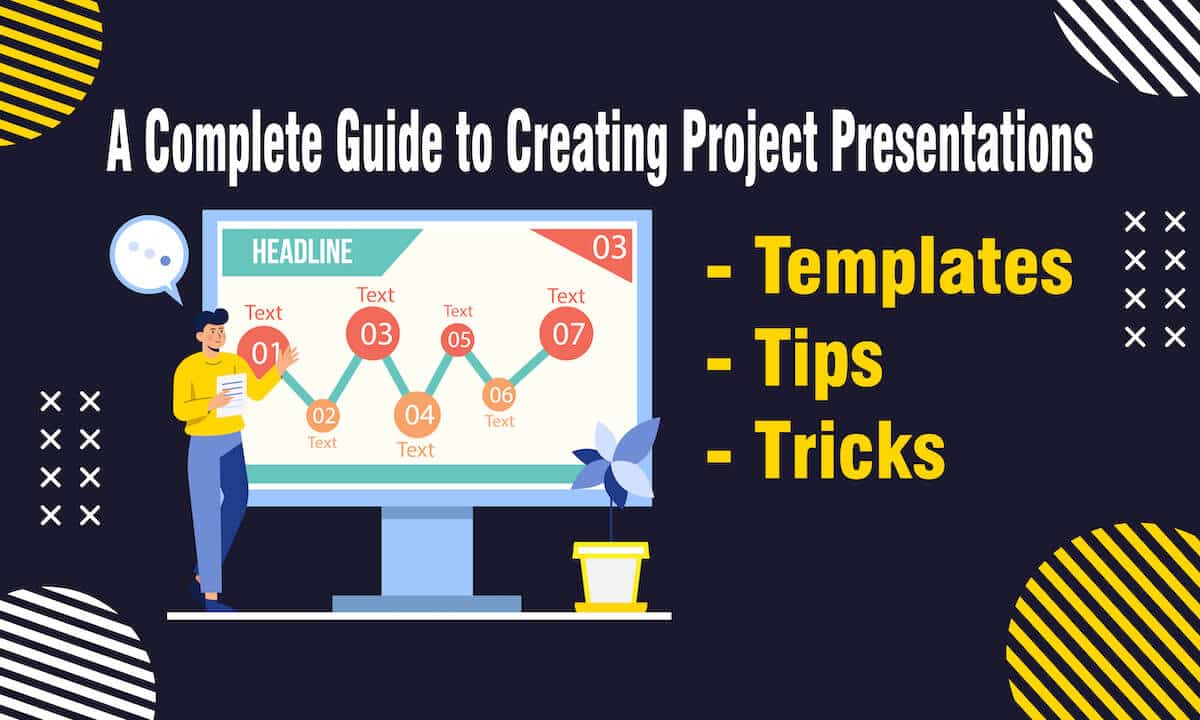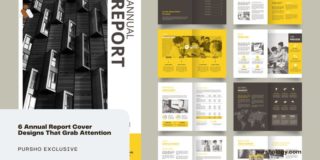Before delving into the article, imagine you are sitting in the audience as an investor, waiting for presentations by two groups on the ‘Clean Water Project’ to begin.
The first presenter starts by simply listing his statistics and discussing technical data. He claims that he put over a dozen of purifiers, his project helped plenty of people in the area, and he showed some numbers and calculations and left the stage.
The second presenter enters and commences with a story of how his installations of water plants uplifted the lives of innumerable people. He shares anecdotes about his visit to designated places, visually describes the challenges those communities face, and then changes the narrative to how his team uplifted them and brought them out of misery. With each slide, he showcases numbers and backs them with an anecdote.
Which presenter are you more likely to finance? Of course, it would be the second one because he presented his project by incorporating all necessary details and left behind an indelible mark on you with his presentation.
Thus, one great project presentation can change your career forever, and its importance cannot be overstated. It serves as a critical platform for conveying a project’s vision, goals, and impact. Effective presentations also allow you to receive feedback, gather suggestions, and improve your plans.
In this blog, we will provide a complete guide to creating a project presentation, including certain templates that you can use to bring another level of charm to your slides.
Tips to Ace Your Project Presentation
1. Open with a Strong Title
Commencing with a strong title holds immense importance as it sets the stage for success. A compelling heading can ignite the audience’s curiosity and draw them toward your slides. It also serves as a clear focal point, giving them a preview of what to expect and guiding their expectations.
For instance, if you are delivering a presentation on a Solar Project, instead of saying, “Solar Project Presentation,” you can begin with, “Powering the Future: Brightening Lives with Our Solar Project.”
Such a well-crafted title not only intrigues the viewer but also helps establish the main theme or message of the presentation.
2. Define Who You Are Presenting To
Defining your audience is crucial to ensure effective communication and engagement.
Let us understand this with the help of an example. Assume that you are presenting a project to a group of investors. Here, understanding their perspective is key to success. You can tailor your content to address their specific interests, such as potential return on investment, environmental impact, or market trends. By highlighting the project’s financial benefits and long-term sustainability, you can capture their attention and make a persuasive case for investment.
On the other hand, if you are presenting to your managers and team members, including data on project status, timeline, potential threats, change in market status, etc., can be more relevant.
Thus, defining your audience allows you to deliver a presentation that speaks directly to their needs, interests, and motivations, increasing the chances of achieving your goals.
3. Be Prepared for Grilling Questions
Preparing for questions in a project presentation is crucial for maintaining credibility and demonstrating expertise. It shows that you have thoroughly considered potential concerns and have comprehensive knowledge of your project.
By anticipating challenging questions, you can gather necessary information and rehearse your responses to ensure clarity. It is also crucial to thoroughly understand every aspect, such as project objectives, methodology, strategies, etc.
You can also support your responses with evidence such as data, research, or examples that might strengthen your arguments. Remember to stay calm and composed and answer with sheer confidence.
4. Weave a Story Around Your Project
Imagine transporting your audience to a world where your project comes to life through a captivating story. What a wonderful way it would be to convey and convince simultaneously.
Weaving a narrative gives you the power to captivate, engage, and leave a lasting impact on your audience.
For instance, let’s consider a project aimed at developing a sustainable fashion brand. You can begin by painting a picture of the current garment cycle- low-wage workers, dump yards filled with tons of unworn clothing items, and lack of awareness amongst people. Then, introduce your project, where every clothing item is fairly priced, wages are regularized, and garments are sustainable and biodegradable, which leads to a better environment for all of us.
As you progress, share the challenges encountered – limited resources, conflicting visions – but emphasize the resilience and determination to overcome obstacles. Illustrate the transformation with anecdotes of individuals rediscovering the joy of slow fashion and how it completely changed the face of the industry.
By showcasing the project as a story of empowerment, environmental stewardship, and social cohesion, you can connect with your audience on an emotional level, inspiring them to support and be part of the narrative. The power of storytelling lies in its ability to create an immersive experience that transcends facts and figures, resonating with the hearts and minds of your audience and compelling them to take action.
5. Talk About the Problem and Solution
In any project presentation, addressing the problem and presenting a clear solution is essential. By clearly outlining the issue at hand, you establish the context and set the stage for your audience to understand the significance of your project. Then, by presenting a well-defined solution, you demonstrate how your project directly addresses the identified problem.
Let’s consider an example of a project focused on reducing plastic waste in a coastal community. Here you can start by describing the alarming levels of plastic pollution on the local beaches and its detrimental impact on marine life and the environment. Highlight the consequences, such as polluted waters, endangered species, and negative effects on the local economy.
Then, introduce your project as a comprehensive solution that involves community education programs, recycling initiatives, and the promotion of sustainable alternatives to single-use plastics. Present evidence of similar projects that have successfully reduced plastic waste in other communities.
By clearly articulating the problem and offering a solution, you create a sense of urgency and showcase the value and impact of your project. This approach engages your audience by highlighting the importance of your work and rallying support for a cause that resonates with their values and the well-being of the community and the environment.
6. Use Charts and Visuals to Showcase Numbers
When showcasing numerical data in a project presentation, utilizing charts and visuals is a powerful strategy to enhance understanding and engagement. Rather than overwhelming your audience with a barrage of numbers, graphs provide a clear representation of the data.
For example, if you’re presenting financial projections for a business project, you can create a bar chart that displays revenue growth over time, allowing your audience to quickly grasp the upward trend. However, suppose you want to depict budget allocations. In that case, you can use pie charts to showcase the division across different components, making it easier for stakeholders to comprehend the distribution of resources.
You can even use annotations and symbols to highlight the most crucial numbers and showcase key achievements.
By presenting data in a visual format, you enable your audience to make connections, spot patterns, and conclude more efficiently. It also helps emphasize key points and support your ideas by visually highlighting significant milestones or achievements.
7. Focus on the Design
Design plays a critical role in determining the interaction and engagement of your audience. By focusing on design details and elements, you can craft slides that stand out and speak for themselves.
This includes using a consistent brand palette and picking fonts that are clear, inclusive, and easy to read. You must also focus on the layout and organization of your content and ensure that it is easy to follow and visually balanced. Further, incorporating white space can help improve readability.
Templates that You Must Include in Your Project Presentation
Creating visuals, illustrations, and graphics from scratch is quite a burdensome task. Not only does it consume much of your time, but it also draws attention away from the content to the design.
Thus, we recommend using expert-designed templates that can be easily added to your slides and are completely customizable. You can adjust the fonts, change colors, and tailor them according to your requirements.
Here are seven such templates that are a must-have for a successful project presentation.
1. Project Timeline
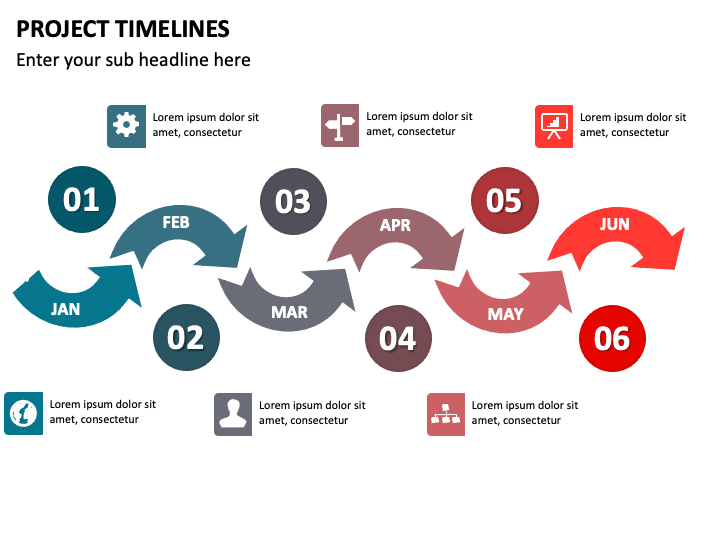
Every project has a timeline that ensures all tasks are being completed as per schedule and allows stakeholders to have a bird’s eye view of important dates and events.
Including a project timeline in your presentation can provide the audience with a visual organization of various stages and milestones of the project. It can foster clear communication amongst team members, help them manage their time effectively, and enhance overall productivity.
Template Link
2. Project Stages
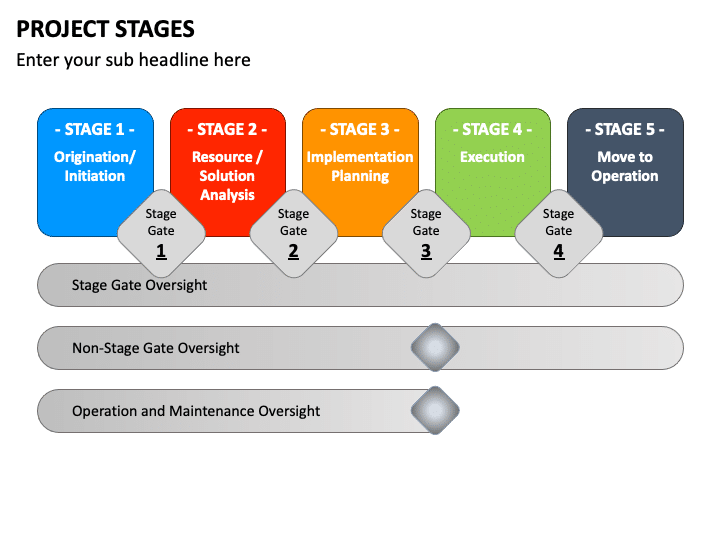
For a project to be successful, it must be well-organized and divided into multiple stages. Right from its conceptualization and initiation to closure, each phase must be outlined properly and presented in a manner that is easy for the audience to comprehend.
With this template, you can showcase even the smallest details, such as the charter, KPIs, tracking, risks involved, lessons learned, and much more.
Template Link
3. Project Management
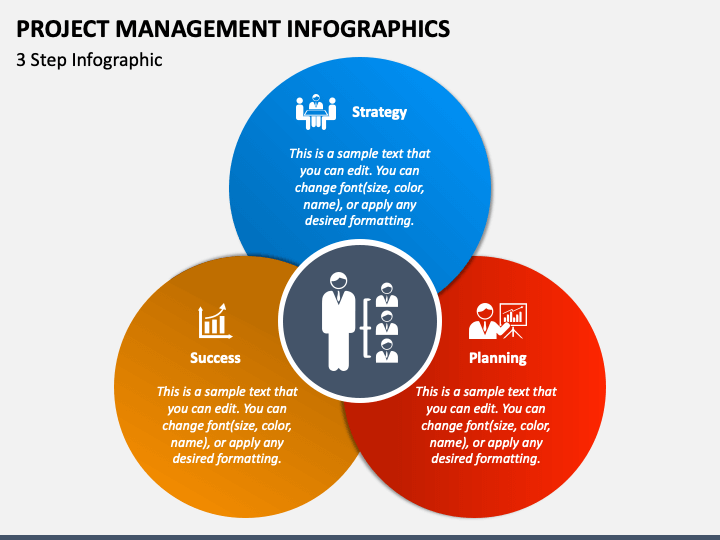
Imagine you’re embarking on a journey to conquer a challenging project. As you gather your team and prepare for it, you realize the importance of having a reliable roadmap that guides you through every twist and turns. That’s precisely what the project management infographic provides.
This template helps you showcase different aspects of the project and allows you to provide insights to your team into monitoring progress, identifying bottlenecks, and making timely adjustments.
Template Link
4. Project Action Plan
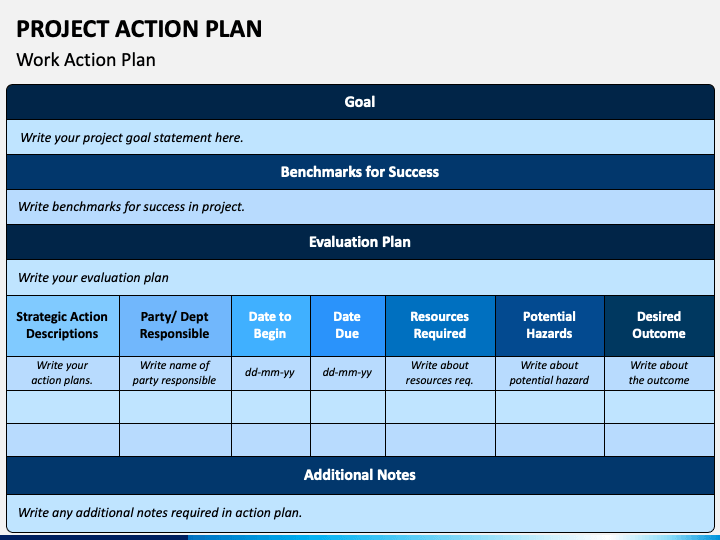
We all have big visions and dreams. But it is true that dreams alone won’t get us there – we need a well-crafted action plan that can transform aspirations into actionable steps.
Thus, using an Action Plan template allows you to depict your project’s goals, objectives, vision, and desired outcome. This template is not just a tool – it’s a catalyst for transformation that allows you to guide your team in the right direction.
Template Link
5. Project Roadmap
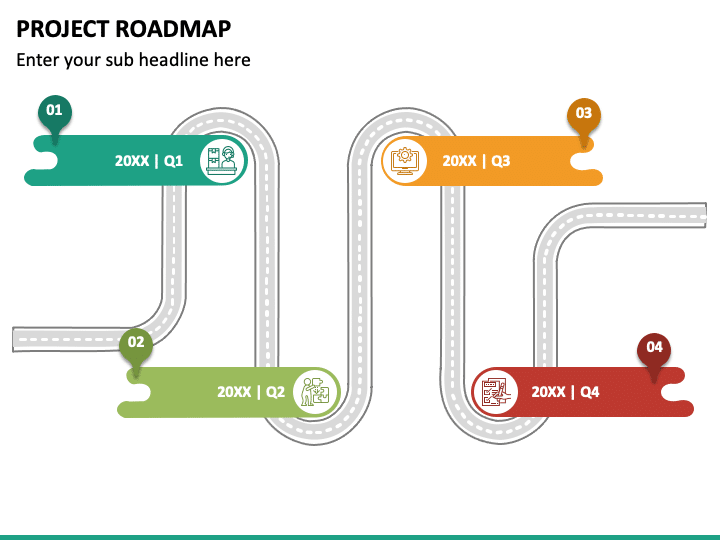
A roadmap is just a simple visual representation of the goals that you need to achieve at particular time periods to finish your project on time. Using a template saves you from the hassle of crafting a graphic from scratch and saves much of your time.
This template serves as a crucial element that can showcase various phases, deliverables, quarterly goals, etc., in one place. It communicates your project’s trajectory and becomes a common reference point for all stakeholders, ensuring that everyone is on the same page and aligned with the project’s objectives.
Template Link
6. Project Budget
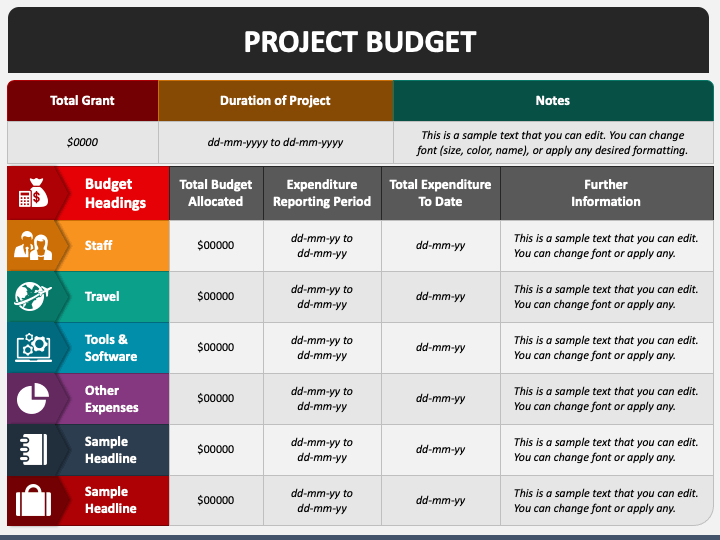
The success of a project depends on its careful financial management. Thus, using a Project Budget template, you can present estimated costs, from personnel and resources to equipment and overhead expenses. You can also depict the allocation of resources and how funds will be distributed across various project activities and phases.
By harnessing the power of this template, you can flawlessly communicate the project’s financial aspects to investors or team members.
Template Link
7. Project Roles and Responsibilities
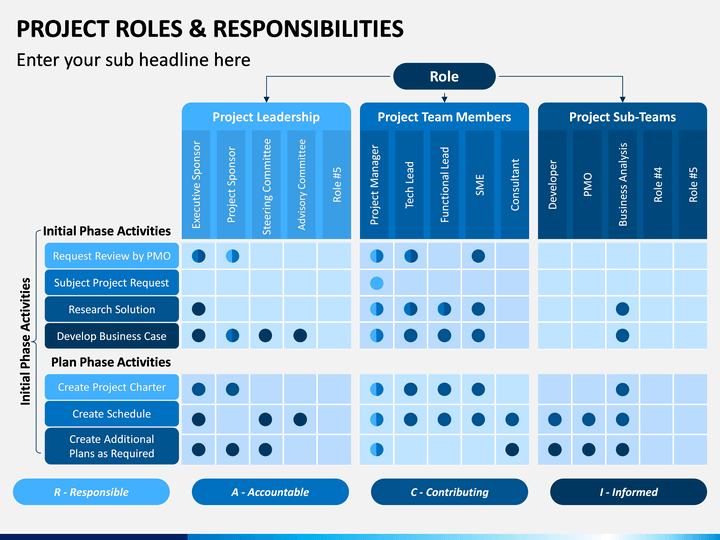
Every project requires effort from all individuals on the team. Each member has a unique role to play and a responsibility to shoulder. Therefore, incorporating a Roles and Responsibilities template allows you to showcase everybody’s duties and tasks clearly.
By visually representing the interdependencies and interactions between different roles, you can help team members understand how their contributions fit into the larger project puzzle. This understanding enhances coordination, minimizes gaps, and maximizes the collective impact of the team.
Template Link
Conclusion
Project presentations are not just about numbers and data. Rather, they are about inspiring, connecting, and convincing the audience. They serve as an excellent tool to showcase your ideas and achievements and support them with concrete facts.
We hope this article acts as a guiding light for your next presentation and helps you successfully create and deliver it.
Looking For Powerpoint Design Agency?
Call Pursho @ 0731-6725516
Telegram Group One Must Follow :
For Startups: https://t.me/daily_business_reads
#Complete #Guide #Creating #Project #Presentations

